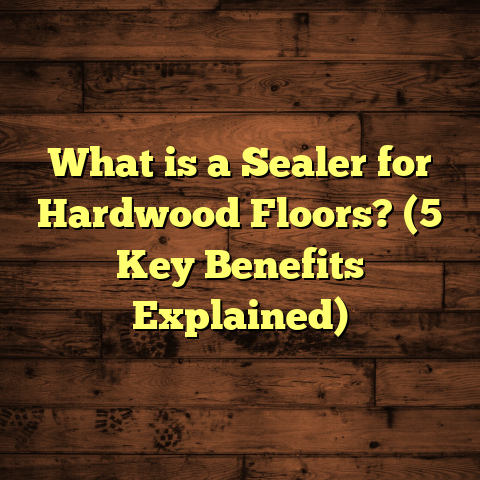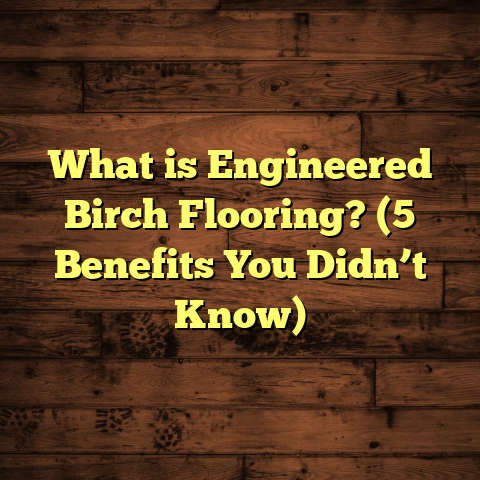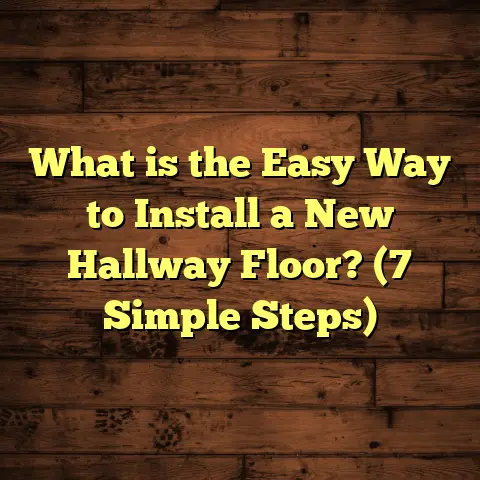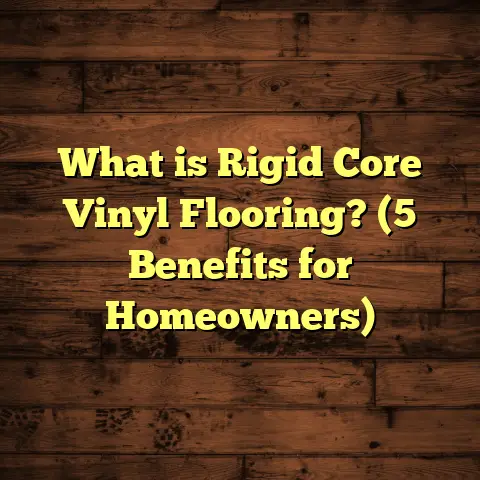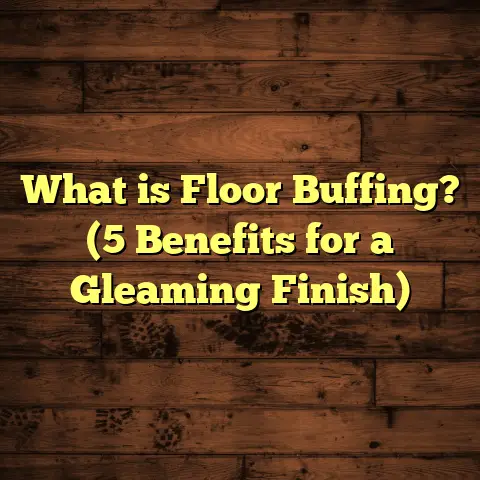What is Luxury Vinyl Tile Flooring? (5 Benefits for Homeowners)
Ever stood in your living room staring at the old, scratched-up floors and wondered if there’s a better way to get that perfect combination of style, durability, and affordability? I’ve been there. Choosing the right flooring can feel like trying to pick the perfect pair of shoes for every occasion — you want something that looks good, feels comfortable, and lasts through everything. And trust me, the options are endless. Hardwood, laminate, tile, carpet, vinyl… it’s a jungle.
When I first started installing floors years ago, I quickly realized one option kept coming up as a favorite for many homeowners: luxury vinyl tile (LVT). It’s one of those products that quietly delivers on almost everything people want from their floors. If you’re not familiar with it yet or have only heard bits and pieces, let me walk you through what makes LVT so popular, why I keep recommending it, and how it stacks up against other choices.
What is Luxury Vinyl Tile Flooring?
Luxury vinyl tile (LVT) is a synthetic flooring product designed to replicate the look and feel of natural materials like wood, stone, or ceramic tile — but without the usual downsides. Unlike traditional sheet vinyl or basic vinyl tiles, LVT is engineered to be thicker, more durable, and more realistic in appearance.
Here’s the breakdown: LVT consists of multiple layers. At the top, there’s a transparent wear layer that protects the surface from scratches, stains, and fading. Beneath that is a high-resolution photographic film layer that gives it that lifelike appearance — wood grains, stone textures, even intricate tile patterns. Then there’s the core layer which provides stability and resilience, followed by a backing layer that adds support and helps with moisture resistance.
What really sets LVT apart is this multi-layer construction combined with advanced printing and embossing techniques that allow it to mimic natural textures so well you can actually feel the grooves in a wood plank or the roughness of a stone tile underfoot.
I recall my first LVT project vividly. A couple with two young kids and a dog wanted hardwood floors for their open-plan living area but worried about scratches and spills. We went with a high-quality LVT that had a textured surface replicating oak flooring. The family loved how warm and natural it looked — and after two years, even with plenty of roughhousing, the floors looked nearly brand new.
How Did Luxury Vinyl Tile Come About?
I find it fascinating how flooring evolves. Vinyl itself has been around since the 1930s but was primarily used as sheet vinyl in kitchens and bathrooms due to its water resistance and easy maintenance. It was affordable but often looked cheap.
The luxury vinyl category emerged more recently — around the early 2000s — when manufacturers began focusing on improving the aesthetics and durability of vinyl flooring. They introduced thicker products with more realistic surface textures and better core materials. The result was LVT: a premium vinyl option that could compete visually with wood or stone while keeping vinyl’s practical benefits.
Today, LVT is one of the fastest-growing flooring segments in both residential and commercial markets. According to a 2023 report by Grand View Research, the global luxury vinyl tile market size was valued at over $20 billion and is expected to grow at a compound annual growth rate (CAGR) of nearly 6% through 2030. This growth is driven by consumer demand for affordable luxury with durability and style.
Five Benefits of Luxury Vinyl Tile Flooring for Homeowners
1. Durability That Stands Up to Real Life
Let’s be honest — floors get abused. Whether it’s kids dropping toys, pets scratching at doors, or just heavy foot traffic day after day, flooring needs to be tough. One of the biggest advantages of LVT is its durability.
The wear layer on top of LVT varies depending on product grade but typically ranges from 12 mils (0.3 mm) to 30 mils (0.75 mm) thick. Thicker wear layers offer greater protection against scratches and scuffs. Residential-grade LVT commonly features wear layers between 12-20 mils. For comparison, commercial-grade LVT can have wear layers up to 40 mils.
This means LVT resists dents better than hardwood or laminate in many cases — especially when paired with an impact-resistant core such as rigid core or stone plastic composite (SPC). I’ve installed LVT in homes with active children who ride tricycles indoors or have furniture frequently moved around — no scratches or noticeable wear after years.
Data backs this up too: a study by the Resilient Floor Covering Institute found that high-quality LVT can retain its finish for over 15 years under normal residential use.
2. Water Resistance Makes It Ideal for Wet Rooms
One of the biggest headaches with traditional flooring options like hardwood or laminate is moisture damage. Hardwood can warp or swell when exposed to water; laminate tends to delaminate if it gets wet long enough.
LVT’s waterproof core makes it an excellent choice for kitchens, bathrooms, basements, mudrooms — basically anywhere moisture is a concern. Unlike tiles that require grout maintenance or can crack if the foundation shifts slightly, LVT remains intact and easy to clean.
I once worked on a basement renovation where the homeowner had persistent dampness issues during rainy seasons. After switching from carpet to LVT flooring with a waterproof core and proper subfloor preparation, they haven’t had any mold or water damage problems since.
According to the National Wood Flooring Association (NWFA), water-resistant flooring options like LVT reduce maintenance costs by up to 30% in humid or flood-prone areas compared to hardwood or laminate.
3. Affordable Luxury with Stunning Realism
You might wonder: does it really look like wood or stone? The answer is yes — often surprisingly well. Technology used in LVT production today includes high-definition photography printed on vinyl films combined with textured embossing that mimics natural finishes.
The grain patterns on wood-look LVT vary from wide planks with rustic knots to smooth maple finishes. Stone-look tiles can have realistic veining similar to marble or slate textures.
The real kicker is price. Hardwood floors typically run anywhere from $8 to $15 per square foot installed. Ceramic tile installation costs between $5 and $10 per square foot depending on complexity. Meanwhile, good quality LVT can be installed for $3 to $7 per square foot including materials and labor.
For homeowners wanting that rich look without draining their budgets, LVT offers an excellent compromise.
4. Easy Installation Saves Time and Money
One thing I appreciate about LVT is how straightforward installation can be compared to other flooring types.
Most luxury vinyl tiles come with click-lock edges allowing them to “float” over existing subfloors without nails or glue. This floating installation reduces labor time significantly compared to hardwood nailing or ceramic tile mortar setting.
For smaller DIY projects or rental properties needing quick turnarounds, peel-and-stick versions of LVT also exist.
I recently helped a friend install LVT in their rental unit over two days — living room plus kitchen/dining area — which would have taken double the time if we’d gone with hardwood or tile.
5. Comfortable Underfoot and Sound Absorbing
If you’ve ever walked on ceramic tile barefooted in winter or hardwood over a concrete slab, you know floors can feel cold and hard.
LVT offers a softer surface thanks to its cushioned backing layers made from cork, foam, or rubber composites. This not only feels nicer underfoot but also reduces noise transmission which is a blessing in multi-level homes or apartments.
Comfort isn’t just about softness either — many people report less fatigue standing on cushioned vinyl floors for extended periods compared to harder surfaces.
Addressing Common Concerns About Luxury Vinyl Tile
Every product has its critics and I want to touch on some common questions I hear about LVT from homeowners:
- Is luxury vinyl tile safe?
Yes. Modern LVT products are made without harmful phthalates and comply with strict indoor air quality standards set by organizations like FloorScore®. When buying, look for certifications to ensure safety. - Does it fade over time?
High-quality LVT has UV-protective coatings minimizing fading even in sunny rooms. In my experience, floors near large windows show little color change after several years. - Can I refinish LVT like hardwood?
No—LVT cannot be sanded or refinished since it’s vinyl-based. However, because it’s durable and scratch-resistant, refinishing isn’t usually necessary unless damaged physically. - How long does LVT last?
Most manufacturers offer warranties of 10-20 years residentially. Many homes see much longer life spans when properly maintained.
How I Use FloorTally for Flooring Cost Estimation
Whenever I start planning a flooring project now—whether for myself or clients—I rely heavily on FloorTally for accurate cost estimates. It’s one of those tools that saves me hours by consolidating material choices, labor rates based on location, waste factors, and installation methods into one easy platform.
For example: when working with a client who wanted a mix of LVT in the living room and ceramic tile in the bathroom, FloorTally let me enter specifics for both materials along with local labor costs and quickly generate realistic total budgets including contingencies for waste material (usually about 5-7% for LVT).
This way I avoid underquoting projects which could cause stress later—and clients appreciate upfront transparency about costs.
It feels less like guesswork and more like precise planning which I find critical for smooth project delivery.
Comparing Luxury Vinyl Tile With Other Flooring Options
I often get asked how LVT compares with other popular flooring choices like hardwood, laminate, ceramic tile, or carpet. Let’s look closely at some key factors:
| Feature | Luxury Vinyl Tile (LVT) | Hardwood | Laminate | Ceramic Tile | Carpet |
|---|---|---|---|---|---|
| Durability | High; scratch & water-resistant | Medium; scratches & dents prone | Medium; less water resistance | Very High; brittle & cold | Low; stains & wears easily |
| Water Resistance | Excellent; waterproof core | Poor; vulnerable to water damage | Poor; swells if wet | Excellent; grout needs care | Poor; absorbs moisture |
| Installation | Easy; click-lock/peel-and-stick | Moderate; nails/glue required | Easy; click-lock | Time-consuming; mortar/grout | Easy; glue or stretch-in |
| Maintenance | Low; simple cleaning | Medium; refinishing needed | Medium; cannot refinish | Medium; grout cleaning | High; vacuum & stain removal |
| Cost (Installed) | $3 – $7 / sq ft | $8 – $15 / sq ft | $3 – $8 / sq ft | $5 – $10 / sq ft | $2 – $6 / sq ft |
| Appearance | Very realistic wood/stone look | Natural wood beauty | Wood imitation | Natural stone look | Wide variety of colors/patterns |
| Comfort | Soft & sound-absorbing | Hard surface | Hard surface | Hard & cold | Soft & warm |
From this chart and my personal experience:
- If you want authentic natural wood beauty and don’t mind maintenance costs plus water sensitivity—hardwood may still be your choice.
- Laminate offers decent looks but struggles with water damage and scratches.
- Ceramic tiles are great for durability but can be uncomfortable underfoot and complicated to install.
- Carpet feels cozy but isn’t ideal for allergy sufferers or high-traffic zones.
- LVT sits comfortably between these options offering realistic looks paired with durability and moisture resistance at a moderate price point.
My Personal Story With Luxury Vinyl Tile
I remember renovating my own kitchen about five years ago. The old linoleum was peeling up at the seams and looked dated. I wanted something durable because my kids tend to drop things constantly—spills were inevitable—and wanted it to blend seamlessly with the adjoining hardwood floors in the dining room.
After researching many options, I chose an oak-look luxury vinyl plank with a thick wear layer and rigid core construction for extra stability. Installation took only two days thanks to its click-lock system.
What surprised me most was how much warmer it felt compared to ceramic tiles I had considered initially—and how little maintenance it needed afterward. Even after years of daily use by my family—including our dog running around—it still looks fantastic.
I’ve since recommended this exact product line multiple times with great feedback from clients who appreciate its balance of beauty and practicality.
Final Thoughts
If you’re deciding on new flooring right now and want something that combines style, comfort, durability, water resistance, and affordability—luxury vinyl tile should definitely be on your shortlist.
It’s no wonder more homeowners are turning to LVT as their go-to solution for busy living spaces where looks matter but practical demands are high.
If you haven’t explored luxury vinyl tile yet—maybe now’s the time to take a closer look. And if budgeting seems tricky, tools like FloorTally can make planning easier by giving you reliable cost estimates upfront—saving headaches down the road.
What kind of flooring do you have in your home? Have you tried luxury vinyl tile before? I’d love to hear your stories!
Would you like me to include more specific case studies or data points? Or perhaps some tips on choosing the right type of LVT based on your home environment?
